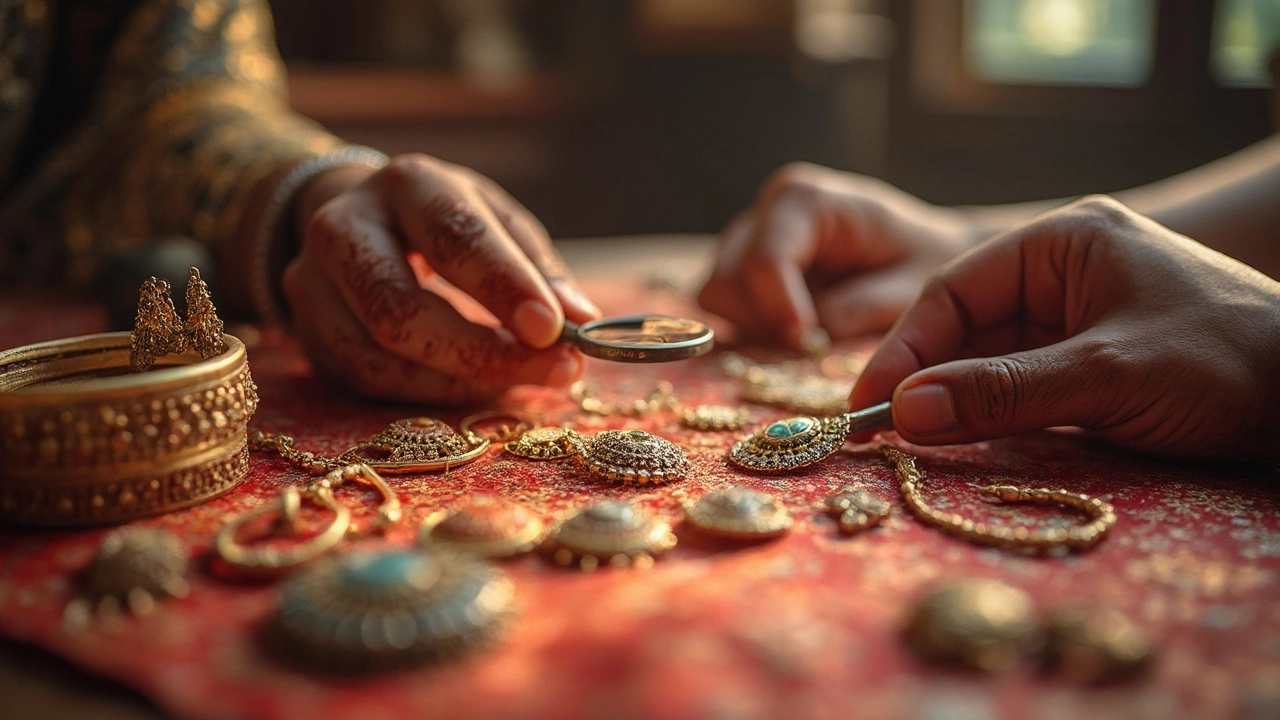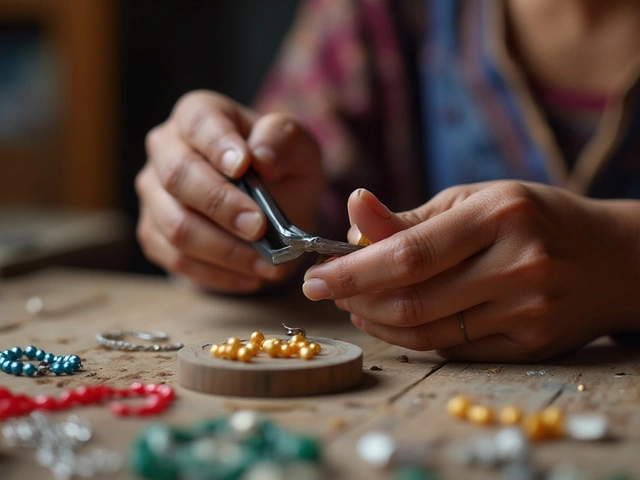
You’ve probably heard stories of someone selling a ring for quick cash, only to find out later it was worth ten times more. It happens all the time, especially with antique jewelry. The resale world is filled with smooth talkers and confusing jargon, so you’ve got to go in prepared.
First things first, don't rush. Take time to figure out exactly what you have before you talk to buyers. Many antique pieces aren’t just old—they might have rare stones, unique craftsmanship, or even a famous designer’s mark tucked away in a place you’d never notice. Missing these details is a surefire way to leave money on the table.
- Know What You’re Selling
- Get It Appraised—By the Right Person
- Picking Where to Sell
- Red Flags and How to Protect Yourself
Know What You’re Selling
If you want to avoid getting lowballed, you need to know exactly what’s in your jewelry box. Start by checking for any stamps or marks—these can tell you about the metal’s purity, the maker, or sometimes even the age of the piece. For example, “14K” means 58.5% pure gold, and “925” means sterling silver. Don’t ignore marks in odd places; check the inside of rings, the back of pendants, and clasp tags.
Antique jewelry is a whole different ballgame compared to something you just bought at the mall. Age, craftsmanship, and history add value. If your piece is from the Art Deco period (1920s-1930s) or Victorian era, it might be worth more than it looks. Designer names like Cartier, Tiffany, or Van Cleef & Arpels can push the value higher—sometimes by thousands. Look for signatures, even if they’re faint.
Gemstones also make a big difference. Not all colored stones are the same—some sapphires or rubies are worth way more than others, especially if they’re untreated or from famous sources like Kashmir or Burma. Diamonds? Cut, color, clarity, and carat mean everything. Even a small bump in clarity can double the price. Here’s a quick table to give you an idea of how much value details can add:
| Detail | Potential Value Increase |
|---|---|
| Well-known Maker | 2x–10x |
| Original Period (not reproduction) | 1.5x–5x |
| Untreated Gemstones | 1.3x–3x |
| Rare Gemstone Source | 2x–8x |
Not sure what you’ve got? Snap some clear photos and hop onto collector forums, or use resources from places like the Gemological Institute of America (GIA). There are free guides to help with basic identification. The goal here: enter any selling conversation armed with real information. When you confidently name what you’ve got—a Victorian-era 18k gold brooch with natural rubies—you’re way less likely to get shortchanged on your sell jewelry deal.
Get It Appraised—By the Right Person
If there’s one step you can’t skip, it’s getting your antique jewelry appraised. There’s a massive difference between someone telling you, “This looks old,” and a real pro breaking down exactly what you’ve got, including details you can use to back up your price. Not all appraisers are equal, though. Some just eyeball things and rush you out the door; others give you a full write-up you can use when negotiating.
Look for someone who’s certified—think jewelry appraisal experts listed with organizations like the Gemological Institute of America (GIA) or the American Society of Appraisers (ASA). Certified appraisers follow clear rules, won’t lowball you just to score a cheap deal for themselves, and most will provide a detailed, written report with photos and breakdowns of stones, metals, hallmarks, and age.
- Find local appraisers by searching professional groups or asking at reputable jewelry stores (bonus points if the store doesn’t buy jewelry, since there’s no conflict of interest).
- Ask what’s included in their fee—a real appraisal should give you paperwork that helps when you sell it later, not just a “ballpark guess.”
- If your piece is especially unique or comes from a big-name designer, seek out someone with experience in that area. Sometimes auction houses will appraise specialty pieces, and their estimates can be more trusted by collectors or high-end buyers.
If you get two very different values from different sources, ask them what they based their number on. Don’t be afraid to get a second or even third opinion, especially for rare or one-of-a-kind items. The cost for a professional appraisal usually lands between $50-150, and it’s worth every cent if it means not getting taken for a ride.

Picking Where to Sell
The spot you choose to sell your jewelry can make or break your deal. Not every option gets you the best price, and some places are flat-out risky. Before you settle, look at what’s out there and what works for your piece.
Here’s the real talk about your choices:
- Local jewelers - They’re convenient and you get face-to-face service, which is great for asking questions. Sometimes, though, they offer less since they want room for profit on resale. Still, if the jeweler is trustworthy, this can be a safe, quick option.
- Pawn shops - They move fast but will usually pay the lowest, often just for the melt value of the gold or silver, ignoring collectible appeal. Use this only for quick cash, not maximum value.
- Auction houses - Decent for rare or high-value antique jewelry. Big names like Sotheby’s and Bonhams handle lots of vintage pieces. They charge fees (sometimes 10-20%) and a sale isn’t guaranteed, but pieces can fetch far more if they attract the right bidders.
- Online marketplaces (like eBay or Etsy) - You reach millions, set your own price, and can showcase your jewelry with good photos and a detailed story. Downside: scams do happen and you might have to deal with tough questions or returns.
- Specialist antique dealers - These folks usually know what sets antique jewellery apart. They might offer more for rare details and designer marks most pawn shops skip.
Here’s a quick side-by-side to help compare your choices:
| Where to Sell | Typical Offer | Speed | Best For |
|---|---|---|---|
| Local Jeweler | Medium | Fast | Everyday items & basic antiques |
| Pawn Shop | Low | Very Fast | Quick cash, low-value pieces |
| Auction House | High (if it sells) | Slow | Rare, valuable antiques |
| Online Marketplace | Varies | Medium | Unique items, tech-savvy sellers |
| Antique Dealer | Medium-High | Medium | True antique pieces |
Jeffrey Post, former curator at the Smithsonian’s National Gem Collection, once pointed out,
“There’s no one-size-fits-all answer. The right place depends on your jewelry’s story and your patience.”
If you want the most for your antique jewelry, take time to research each option. Don’t be afraid to shop your piece around and get more than one offer. One last thing—a lot of people get burned by mailing out their valuables to someone they’ve never met. Unless it’s an established company with real reviews, and insured shipping, don’t risk it.
Bottom line: slow and steady usually wins, especially with antique jewellery. Choose smart, stay alert, and know your worth.
Red Flags and How to Protect Yourself
Scams in the sell jewelry world are more common than you’d think. Folks are still losing thousands to shady dealers who either rush the deal, pay in funny ways, or flat-out disappear with the piece. If a buyer seems too eager, watch out. Real pros will ask questions and explain their offer, not shove cash in your hand just to get you out the door.
If someone tries to weigh gold with their own unmarked scale, or refuses to look up paperwork right in front of you, big red flag. Offers that are well below your appraisal or way above the usual price ("I’ll pay double right now!") don’t add up either. Authentic buyers will gladly walk you through their process, and usually have a physical store, licensing, or at least a history you can search online.
- Never hand over your jewelry without paperwork showing the terms.
- Don’t deal with buyers who insist on cash only or pressure you to close fast.
- Double-check background info—look for reviews, real addresses, and business licenses.
- Avoid “mail-in” buyers unless they’re a proven brand like Worthy or established auction houses.
- Record serial numbers or take clear photos of your item before any meeting.
Stats show that about 30% of folks selling antiques in the US run into at least one dishonest buyer on their first try. Most issues happen with unlicensed pop-up buyers or online "brokers" who offer quick deals—but barely pay half the market price. See below for a quick comparison:
| Type of Buyer | Average Offer (% of Appraisal) | Risk of Scam |
|---|---|---|
| Pawn Shop | 40-60% | Moderate |
| Online Broker (unverified) | 30-50% | High |
| Certified Jeweler | 75-90% | Low |
| Auction House | Varies (can be 100%+ after fees) | Low |
Bottom line: trust your gut, check credentials, and keep proof of every conversation and transaction. If something feels off, walk away—there’s always another buyer out there.


